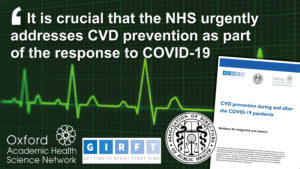 A new practical guide is helping teams in healthcare systems across England to overcome disruption in work to prevent cardiovascular disease (including stroke, heart disease and vascular dementia) caused by Covid-19.
A new practical guide is helping teams in healthcare systems across England to overcome disruption in work to prevent cardiovascular disease (including stroke, heart disease and vascular dementia) caused by Covid-19.
The guidance – a collaboration between the Oxford Academic Health Science Network (Oxford AHSN), the Getting It Right First Time (GIRFT) programme and the Association of Directors of Public Health (ADPH) – outlines how rates of stroke, heart disease and vascular dementia are closely linked to health inequalities which have widened during the pandemic. Lockdowns and other government restrictions are likely to have exacerbated unhealthy behaviour and patients will have had less contact with healthcare professionals, leading to lower detection rates for risk factors such as hypertension and atrial fibrillation.
Many cardiovascular disease (CVD) risk factors are picked up through standard face-to-face primary care appointments, and these have been significantly reduced during the pandemic. NHS Health Checks were also paused for several months. In addition, fewer patients presented with heart attack and stroke during the early phase of the pandemic, suggesting that some cardiovascular issues went unreported and people did not access care, including advice on preventing future health problems.
The broad alliance of Oxford AHSN, GIRFT and the ADPH came together to produce a package of tools to help reverse this trend through a whole system approach. The practical guidance includes best practice case studies from across England and is aimed at those within integrated care systems who are responsible for planning or delivering CVD prevention programmes.
Professor Gary Ford, Chief Executive of the Oxford AHSN, said: “Cardiovascular disease is a major driver of health inequalities – and effective treatment has been one of the major drivers of health improvement in recent decades. Major opportunities still remain to improve the population’s health through better treatment of CVD risk factors. We hope our new guidance will help system leaders improve CVD prevention measures following during and after the pandemic.”
Dr David Hargroves, national GIRFT lead for stroke and a consultant stroke physician at East Kent Hospitals University NHS Foundation Trust, said: “It is crucial that the NHS urgently addresses CVD prevention as part of the response to COVID-19. We know that fewer patients presented with heart attack and stroke during the early phase of the pandemic, but late treatment or no treatment for these conditions will have a negative effect.
“We hope this guidance helps teams get back on track with CVD prevention work, offering innovations and good practice to emulate in their work with patients.”
This is the latest in a series of guides produced by the Oxford AHSN and GIRFT during the pandemic. Previous guidance covered:
- CVD prevention during the COVID-19 pandemic: a guide for primary care (with the Primary Care Cardiovascular Society)
- Restoration and recovery of stroke services during the Covid-19 pandemic (with the British Association of Stroke Physicians)
- Adapting stroke services in the Covid-19 pandemic (with the British Association of Stroke Physicians)

